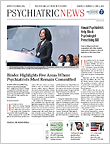Among the many additions and revisions to APA’s Diagnostic and Statistical Manual of Mental Disorders that appeared in its fifth edition (DSM-5) was the incorporation of “mixed features” as a specifier for both depression and bipolar disorder.
Previously, a patient had to be diagnosed as having a mixed episode—that is, presenting with both full depression and mania—while the new designation requires patients to meet only a certain level of symptoms in the mood opposite their predominant diagnosis.
Shefali Miller, M.D., a clinical assistant professor of psychiatry and behavioral sciences at Stanford University, commended this change to recognize mixed features. “It recognizes a phenomenon that’s been long observed but never codified,” she told Psychiatric News.
However, even this new distinction may not adequately capture the full spectrum of patients who have to cope with concurrent manic and depressive symptoms, based on a study by Miller and colleagues published April 15 in AJP in Advance.
The group assessed 907 adult outpatients with bipolar disorder and compared the prevalence of depression with mixed features using different diagnostic thresholds. More than 14,310 physician visits spanning seven years were included in the analysis.
Applying a strict DSM-5-based definition of depression with mixed features, which requires at least three symptoms on the Young Mania Rating Scale (YMRS) that do not overlap with any of the patient’s depressive symptoms, resulted in mixed features being present in 6.3 percent of all visits; a more lenient cutoff that required only two nonoverlapping YMRS symptoms yielded a prevalence of 10.8 percent.
However, if the diagnosis was based only on meeting clinical scores for depression (Inventory of Depressive Symptomatology–Clinician-Rated Version [IDS-C] score of ≥15) and hypomania (YMRS score from 2 to 12) at the same visit, then the prevalence rose to 14.9 percent of all visits, with over 64 percent of patients meeting the criteria during at least one visit.
Not surprisingly, under the more lenient threshold, the most common symptom seen among patients presenting with mixed features compared with unipolar depression was irritability, which is considered an excluded YMRS symptom since it overlaps with an IDS-C symptom.
William Coryell, M.D., the George Winokur Professor of Psychiatry at the University of Iowa College of Medicine and a member of the DSM-5 Mood Disorders Work Group, noted that these findings are consistent with those of other studies about the possible prevalence of mixed features, but that doesn’t necessarily mean the DSM criteria need revision.
“When you’re establishing a new diagnosis, there have to be some thresholds to make it clinically distinct,” he told Psychiatric News.
Coryell acknowledged that the DSM-5 requirements may not capture everyone who should get a mixed features diagnosis, but the available data suggest that the presence of three manic symptoms was the best cutoff.
“However, it doesn’t mean that a diagnosis that’s a little lower than the threshold isn’t clinically meaningful,” he added. “Psychiatrists should have heightened vigilance when any manic symptoms are perceived in a depressed individual.”
Miller also believes that even one-time occurrences of manic symptoms are important, as they can inform prognosis and treatment. For example, three YRMS symptoms that a previous Stanford study had found to be predictive of antidepressant treatment-emergent mania—language-thought disorder, increased speech, and increased motor activity—were among the most prevalent in patients diagnosed with mixed features (along with irritability).
But she also thinks that continued discussion of the DSM-5 definition is warranted. The question of whether to include overlapping symptoms when considering a mixed-features diagnosis is part of the debate, but a more salient issue revolves around whether the mixed-features criteria should be focused on scoring for individual symptoms.
As she explained, while people with mixed features show certain symptoms, a patient displaying that set of symptoms should not necessarily be diagnosed as having mixed features. Criteria that focus more on overall manic severity might be a more reliable approach.
This study was supported by a grant from the Stanley Medical Research Institute. ■
“Mixed Depression in Bipolar Disorder: Prevalence Rate and Clinical Correlates During Naturalistic Follow-Up in the Stanley Bipolar Network” can be accessed
here.
